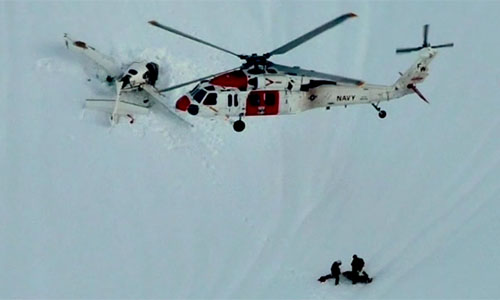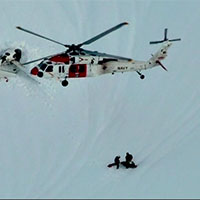— from Mike Welding —
 A Search and Rescue (SAR) team of six from Naval Air Station (NAS) Whidbey Island conducted a Search and Rescue operation for a crashed plane in the Olympic National Park.
A Search and Rescue (SAR) team of six from Naval Air Station (NAS) Whidbey Island conducted a Search and Rescue operation for a crashed plane in the Olympic National Park.
The weekend SAR Alert crew received notification of an airplane crash with survivors in the Olympic National Park just before 4:30 p.m. on Sunday, Apr. 2, 2017, and prepared for immediate launch. Because of the potential for multiple survivors who would require medical attention, the crew elected to take a second Search and Rescue Medical Technician (SMT). The helicopter launched just after 5:15 p.m. and proceeded at maximum speed to the suspected location of the crashed airplane.
At 5:38 p.m., the crew arrived on scene where they coordinated with a fixed-wing Civil Air Patrol asset and both aircraft searched the area. Ten minutes later, the crew located the wreckage of the Cirrus R22 in a valley at 5,700 feet. After conducting multiple low passes over the crash site to determine the existence of hazards and gauge wind effects the crew conducted power checks and set up for recovery. Noting that the downed aircraft’s parachute was not visible, the crew opted to commence an approach to a hover approximately 75 yards away from the wreckage in case it inadvertently deployed, while also preventing blowing debris that could cause further injury or damage.
Just before 6 p.m., both SMTs and the Helicopter Inland Rescue Aircrewman (HIRA) rappelled down to the survivors and commenced medical assessments. The rescue aircraft departed the hover and circled the scene within communications distance to conserve fuel and allow the crewmen to prepare the patients for transport. The SMTs expeditiously treated the survivors, prepared them for transport and called the helicopter back into position as soon as they were ready. During this time, the Civil Air Patrol aircraft was instrumental in relaying the status of the recovery and updating the hospital with patient condition and arrival time.
At 7 p.m., both patients and all three crewmembers were hoisted into the helicopter and transported directly to Harborview Medical Center in Seattle, Wash. for further evaluation.
This was the third rescue of 2017 for NAS Whidbey Island SAR, which has also conducted one search and 13 MEDEVACs totaling 17 lives delivered to a higher level of care.
The Navy SAR unit operates three MH-60S helicopters from NAS Whidbey Island as search and rescue/medical evacuation (SAR/MEDEVAC) platforms for the EA-18G aircraft as well as other squadrons and personnel assigned to the installation. Pursuant to the National SAR Plan of the United States, the unit may also be used for civil SAR/MEDEVAC needs to the fullest extent practicable on a non-interference basis with primary military duties according to applicable national directives, plans, guidelines and agreements; specifically, the unit may launch in response to tasking by the Air Force Rescue Coordination Center (based on a Washington State Memorandum of Understanding) for inland missions, and/or tasking by the United States Coast Guard for all other aeronautical and maritime regions, when other assets are unavailable.
**If you are reading theOrcasonian for free, thank your fellow islanders. If you would like to support theOrcasonian CLICK HERE to set your modestly-priced, voluntary subscription. Otherwise, no worries; we’re happy to share with you.**









Impressive. These guys are awesome!
One of my favorite people, now a USAF major and F-16 pilot, got his start with Civil Air Patrol. Those folks, and the Navy guys, deserve our appreciation.